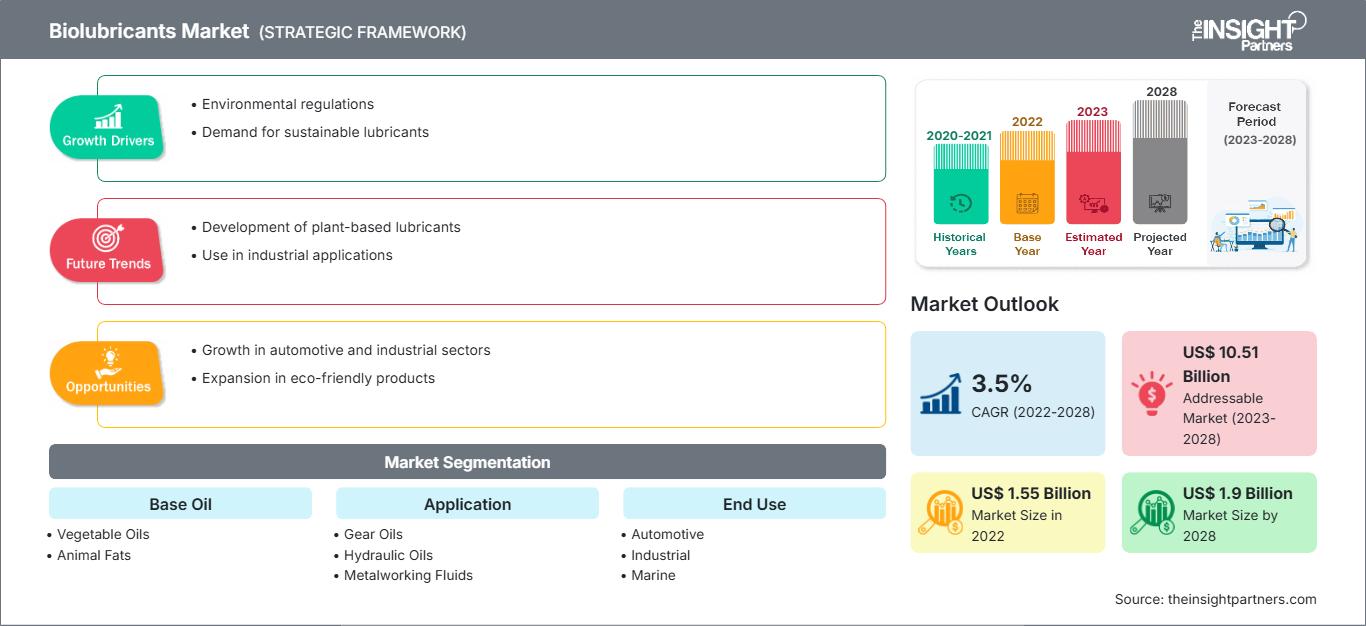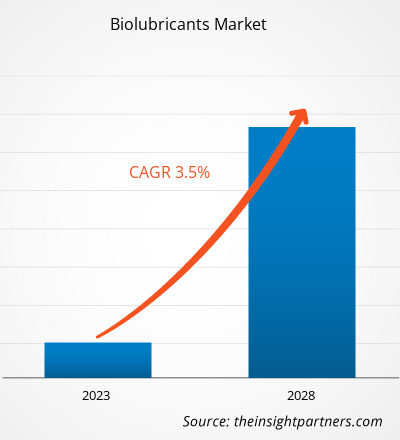Se prevé que el mercado de biolubricantes crezca de 1.551,15 millones de dólares estadounidenses en 2022 a 1.902,41 millones de dólares estadounidenses en 2028; se estima que registrará una tasa de crecimiento anual compuesta (TCAC) del 3,5% entre 2022 y 2028.
Los biolubricantes se elaboran a partir de aceites derivados de vegetales y otros recursos renovables, incluidos productos de origen animal. Son biodegradables y no tóxicos para los seres humanos ni para el medio ambiente acuático. Su biodegradabilidad es fundamental en aplicaciones con alto riesgo de fugas al medio ambiente. Además, presentan puntos de inflamación más elevados, viscosidad constante y menores emisiones de vapor/niebla de aceite, lo que se traduce en mayor seguridad. También generan menos emisiones y poseen una adherencia superior a las superficies metálicas. Se utilizan en diversas aplicaciones, como motores, cajas de cambios, sistemas hidráulicos, motosierras, grasas y motores de lanchas rápidas de dos tiempos. Los biolubricantes tienen un amplio uso en diversas industrias, como la automotriz, la naval, la agrícola y forestal, la minera, la de la construcción, la de transmisión de potencia, la alimentaria y la farmacéutica.
El crecimiento del mercado de biolubricantes se atribuye a la creciente demanda de estos productos por parte de diversas industrias de uso final, debido a una mayor conciencia ambiental, leyes ambientales estrictas que exigen el uso de lubricantes ecológicos y el elevado costo de eliminación de los lubricantes no degradables existentes. En muchos países, existen regulaciones que prohíben el uso de lubricantes a base de aceite mineral en las vías navegables interiores. Estas regulaciones impulsan la demanda de biolubricantes para diversas aplicaciones. Además, dado que los biolubricantes son limpios y no tóxicos, su uso se ha vuelto obligatorio en aplicaciones de alta sensibilidad, como la silvicultura y la industria marítima, en algunos países del mundo. En aplicaciones marítimas, los biolubricantes se utilizan en diferentes secciones y procesos de contenedores, flotas de carga, buques tanque y otros barcos para fines de lubricación. Los biolubricantes marinos incluyen aceites para motores, aceites hidráulicos, aceites para compresores, aceites para guías, aceites para engranajes, aceites de transferencia de calor, grasas, aceites para turbinas, entre otros. Asimismo, el crecimiento del comercio marítimo internacional ha impulsado la demanda de biolubricantes, ya que ofrecen alta eficiencia y bajas emisiones. Por lo tanto, el mayor uso de biolubricantes procedentes de la industria marina ofrecerá oportunidades lucrativas para el mercado de biolubricantes durante el período de previsión.
Obtendrá personalización gratuita de cualquier informe, incluyendo partes de este informe, análisis a nivel de país y paquetes de datos de Excel. Además, podrá aprovechar excelentes ofertas y descuentos para empresas emergentes y universidades.
Mercado de biolubricantes: Perspectivas estratégicas

-
Obtenga las principales tendencias clave del mercado que se describen en este informe.Esta muestra GRATUITA incluirá análisis de datos, que abarcarán desde tendencias de mercado hasta estimaciones y pronósticos.
Perspectivas del mercado
El aumento de la demanda por parte de la industria automotriz impulsa el crecimiento del mercado de biolubricantes
En la industria automotriz y del transporte se utilizan aceites de motor, fluidos de transmisión, aceites para cajas de cambios, fluidos de frenos e hidráulicos, y otros aceites para automóviles. Los biolubricantes se emplean como agentes antifricción y absorbentes de calor, lo que permite un funcionamiento suave y fiable, reduciendo el riesgo de averías frecuentes y prolongando la vida útil del vehículo. Los lubricantes para automóviles se utilizan para reducir la fricción y moderar el calor generado por el contacto entre dos superficies. Además, los aceites de motor de base biológica presentan una mayor tasa de biodegradación inherente, baja toxicidad para los organismos acuáticos y niveles muy bajos de bioacumulación. Asimismo, la sustitución de aceites a base de hidrocarburos por productos biodegradables es una de las maneras de reducir los efectos adversos de los lubricantes en el ecosistema. Ante la creciente presión normativa para mejorar la eficiencia del combustible de los vehículos y reducir las emisiones de gases de efecto invernadero, se ha producido un notable desarrollo en las formulaciones de lubricantes. Estos factores están impulsando la demanda de biolubricantes en la industria automotriz.
Información sobre aceites base
Según el aceite base, el mercado de biolubricantes se segmenta en aceites vegetales, grasas animales y otros. El segmento de aceites vegetales representó la mayor cuota de mercado en 2022. Los aceites vegetales son alternativas preferidas a los aceites minerales como bases lubricantes debido a ciertas propiedades inherentes, como su alta viscosidad, su elevado punto de ebullición y su biodegradabilidad. Los ácidos grasos presentes en el aceite pueden modificarse químicamente para formar ésteres de alto peso molecular, que pueden sustituir a los lubricantes convencionales a base de aceite mineral. Se prevé que estos factores impulsen el crecimiento del mercado de aceites vegetales.
Emery Oleochemicals LLC, Fuchs Petrolub SE, Carl Bechem GmbH, PANOLIN AG, Renewable Lubricants Inc, TotalEnergies SE, Shell Plc, RSC Bio Solutions LLC, Crevier Group Inc y Kluber Lubrication GmbH & Co KG se encuentran entre los principales actores del mercado de biolubricantes. Las empresas líderes adoptan estrategias como fusiones y adquisiciones y lanzamientos de productos para expandir su presencia geográfica y su base de consumidores.
Perspectivas regionales del mercado de biolubricantes
Los analistas de The Insight Partners han explicado en detalle las tendencias regionales y los factores que influyen en el mercado de biolubricantes durante el período de previsión. Esta sección también analiza los segmentos del mercado de biolubricantes y su distribución geográfica en Norteamérica, Europa, Asia Pacífico, Oriente Medio y África, y Sudamérica y Centroamérica.
Alcance del informe de mercado de biolubricantes
| Atributo del informe | Detalles |
|---|---|
| Tamaño del mercado en 2022 | 1.550 millones de dólares estadounidenses |
| Tamaño del mercado para 2028 | 1.900 millones de dólares estadounidenses |
| Tasa de crecimiento anual compuesto global (2022 - 2028) | 3,5% |
| Datos históricos | 2020-2021 |
| período de previsión | 2023-2028 |
| Segmentos cubiertos |
Por aceite base
|
| Regiones y países cubiertos |
América del norte
|
| Líderes del mercado y perfiles de empresas clave |
|
Densidad de los actores del mercado de biolubricantes: comprensión de su impacto en la dinámica empresarial
El mercado de biolubricantes está creciendo rápidamente, impulsado por la creciente demanda de los usuarios finales debido a factores como la evolución de las preferencias de los consumidores, los avances tecnológicos y una mayor conciencia de los beneficios del producto. A medida que aumenta la demanda, las empresas amplían su oferta, innovan para satisfacer las necesidades de los consumidores y aprovechan las nuevas tendencias, lo que impulsa aún más el crecimiento del mercado.

- Obtenga una visión general de los principales actores del mercado de biolubricantes.
Reportajes destacados
- Tendencias progresivas en la industria de los biolubricantes para ayudar a los participantes a desarrollar estrategias efectivas a largo plazo.
- Estrategias de crecimiento empresarial adoptadas por las empresas para asegurar el crecimiento en mercados desarrollados y en desarrollo
- Análisis cuantitativo del mercado mundial de biolubricantes de 2020 a 2028
- Estimación de la demanda de biolubricantes en diversos sectores
- Análisis de las cinco fuerzas de Porter para ilustrar la eficacia de compradores y proveedores que operan en la industria de los biolubricantes.
- Últimos avances para comprender el panorama competitivo del mercado y la demanda de biolubricantes.
- Tendencias y perspectivas del mercado, y factores que rigen el crecimiento del mercado de biolubricantes
- Estrategias esclarecedoras que sustentan el interés comercial en relación con el crecimiento del mercado, facilitando el proceso de toma de decisiones.
- Tamaño del mercado de biolubricantes en diversos nodos del mercado
- Descripción general detallada y segmentación del mercado, así como su dinámica sectorial.
- Tamaño del mercado de biolubricantes en diversas regiones con prometedoras oportunidades de crecimiento
El informe "Pronóstico del mercado de biolubricantes hasta 2028" es un estudio especializado y exhaustivo de la industria química y de materiales, centrado en el análisis de tendencias del mercado de biolubricantes. El informe ofrece una visión general del mercado con una segmentación detallada. El mercado de biolubricantes se segmenta según el aceite base, la aplicación, el uso final y la geografía. Según el aceite base, el mercado se divide en aceites vegetales, grasas animales y otros. Según la aplicación, se segmenta en aceites para engranajes, aceites hidráulicos, fluidos para el mecanizado de metales, grasas y otros. Por uso final, el mercado de biolubricantes se segmenta en automoción, industria, sector marítimo, agricultura y silvicultura, y otros. El mercado se divide en cinco regiones principales: Norteamérica, Europa, Asia Pacífico, Oriente Medio y África, y Sudamérica y Centroamérica. En 2022, Europa dominó el mercado de biolubricantes. Se prevé que Asia Pacífico registre la mayor tasa de crecimiento anual compuesto (TCAC) durante el período de pronóstico. Factores como la creciente preocupación por el medio ambiente y el aumento del precio del petróleo crudo impulsan la demanda de biolubricantes en Europa. En la región Asia-Pacífico, la demanda de biolubricantes es directamente proporcional a la industrialización y la producción de vehículos. El auge de la construcción y de los sectores industrial y automotriz en la región acelera el crecimiento del mercado.
- Análisis histórico (2 años), año base, pronóstico (7 años) con CAGR
- Análisis PEST y FODA
- Tamaño del mercado, valor/volumen: global, regional y nacional
- Industria y panorama competitivo
- Conjunto de datos de Excel
Informes recientes
Informes relacionados
Testimonios
Razón para comprar
- Toma de decisiones informada
- Comprensión de la dinámica del mercado
- Análisis competitivo
- Información sobre clientes
- Pronósticos del mercado
- Mitigación de riesgos
- Planificación estratégica
- Justificación de la inversión
- Identificación de mercados emergentes
- Mejora de las estrategias de marketing
- Impulso de la eficiencia operativa
- Alineación con las tendencias regulatorias






















 Obtenga una muestra gratuita para - Mercado de biolubricantes
Obtenga una muestra gratuita para - Mercado de biolubricantes